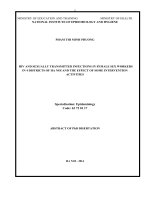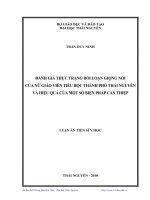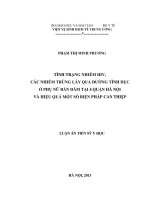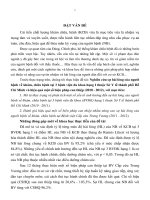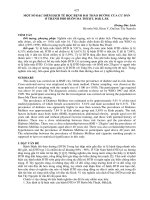Nghiên cứu đặc điểm dịch tễ học bệnh đái tháo đường týp 2 và hiệu quả một số biện pháp can thiệp dự phòng tại tỉnh hưng yên (2013 – 2015) tt tiếng anh
Bạn đang xem bản rút gọn của tài liệu. Xem và tải ngay bản đầy đủ của tài liệu tại đây (207.8 KB, 38 trang )
MINISTRY OF EDUCATION AND TRAINING
MINISTRY OF DEFENSE
MILITARY MEDICAL UNIVERSITY
NGUYEN THI ANH
RESEARCH ON EPIDEMIOLOGICAL CHARACTERISTICS
OF TYPE 2 DIABETES AND EFFECTIVENESS OF SOME
PREVENTIVE INTERVENTION MEASURES
IN HUNG YEN PROVINCE (2013-2015)
Major:
No:
Epidemiology
9 72 01 17
SUMMARY OF DOCTORAL DISSERTATION
HA NOI-2019
THE RESEARCH WAS COMPLETED AT
2
MILITARY MEDICAL UNIVERSITY
Instructor:
1. Dinh
Professor
2 Dao
Professor.
Hong
Duong,
Xuan
Vinh,
Ph.D.,
Ph.D.,
Associate
Associate
Reviewer 1: Professor. Truong Viet Dung
Reviewer 2: Assoc. Professor. Nguyen Thi Phi
Nga
Reviewer 3: Professor. Pham Ngoc Dinh
The dissertation was protected at the school-level council
At … (day) … (month) … ,2019
2
3
The dissertation can be found in:
1.
Vietnam National Library.
2.
Vietnam Military Medical University Library.
LIST OF PUBLISHED RESEARCH
RELATED TO THE AUTHOR’S DISSERTATION
1.
Nguyen Thi Anh, Dao Xuan Vinh, Dinh
Hong
Duong
interventions
(2018).
on
nutrition
Effect
and
of
media
motility
of
patients with type 2 diabetes in Khoai Chau
district,
Hung
Yen
province
in
2014-2015.
Vietnam Journal of Preventive Medicine, Vol
28(2), p.131-138.
2.
Nguyen Thi Anh, Dao Xuan Vinh, Dinh
Hong Duong (2018). Prevalence and factors
associated with type 2 Diabetes among Hung
Yen population aged 25-70 in 2014. Journal of
Military Pharmaco-medicine, vol 43(%), p. 162169.
3
4
4
5
FOREWORDS
The World Health Organization (WHO) Global
Report 2016 on Diabetes states that about 1.5 million
deaths in 2012 are due to type 2 diabetes. In 2014, the
world recorded that type 2 diabetes increased to 422
million cases, equivalent to 8.5% of the population.
According to the WHO, the incidence of type 2
diabetes in 2014 is 7.1% in Africa, 8.3% in America,
13.7% in the Middle East, 7.3% in Europe, 8.6% in
South Asia, 8.4% in the Western Pacific and the global
rate is 8.5%.
In Vietnam, the research results of the National
Institute of Endocrinology in 2011 reported that there
are over 5 million Vietnamese people with type 2
diabetes, accounting for 6% of the population, the
urban community is more prone to the disease than in
rural areas, people with sedentary lifestyles, and those
who abuse high-risk ready-to-eat foods stand a higher
risk. The study also found that 80% of people with the
disease did not change their lifestyle and 60% had
poor glycemic control.
According to the statistics of Hung Yen Preventive
Medicine Center, in 2010, there were 15,344 patients
with type 2 diabetes who went to the provincial
5
6
general hospital and most had eyes and nerve
complications, kidney damage ... The cause is due to
late examination and detection, or by accidental
treatment of other diseases and then found to be
infected. So we do the following:
1. Describe some epidemiological characteristics
and some related factors with pre-diabetes and type 2
diabetes in 25-70 year-old people in Hung Yen
province (2013-2014).
2.
effect
Evaluation
on
of
nutrition,
communication
intervention
exercise
lifestyle
and
of
prediabetes in Khoai Chau district, Hung Yen province
(2014-2015).
New contributions of the dissertation:
The study found that the incidence of type 2
diabetes in Hung Yen was 4.7%; pre-diabetes was
25.4%.
Five
(05)
factors
are
considered
to
be
associated with pre-diabetes: angina, being above 49
years old, having sibling with diabetes, unknown risk,
not eating peanuts. Three (03) factors were associated
with diabetes mellitus in subjects with Hypertensive
substance (BP measurement), 49 years of age or older,
with siblings with diabetes mellitus.
6
7
The
evaluated
study
used
efficacy
media
with
interventions
multidisciplinary
but
control
evaluation criteria as guided by the Ministry of Health.
The results indicate that a set of criteria can be used
to assess the control of type 2 diabetes and diabetes
in the community.
Dissertation structure
A total of 133 pages including: 2-page issue set;
Chapter 1: Overview of 34 pages; Chapter 2: Object
and Methodology 25 pages; Chapter 3: Research
Results 43; Chapter 4: Discuss 26 pages; Conclusion
01 page, 01 page proposal.
The thesis has: 41 tables, 1 figure and 19 charts, 102
references.
7
8
Chapter 1: OVERVIEW
1.1. Type 2 diabetes and related factors
1.1.1. Status of type 2 diabetes mellitus
1.1.1.1. The diabetes status in the world
According to the report by WHO in 2016, diabetes
mellitus has increased steadily in recent decades. Type
2 diabetes is a global health and economic crisis that
threatens the health and wellbeing of all countries,
especially in developed countries. In the global report
on type 2 diabetes in 2016, there are 422 million
people worldwide with type 2 diabetes. Thus, the rate
of people having type 2 diabetes increased to 8.5% in
2014, which was just 4.7% in 2008. About 2% of
deaths among 1.5 million people in 2012. As stated by
WHO, about 43% of deaths before the age of 70 were
related to high blood glucose levels, equivalent to 1.6
million deaths. High blood glucose mortality is
associated with age and the age having risk factors
ranging from 50-79 years.
1.1.1.2. Situation of type 2 diabetes in Vietnam
In Vietnam, type 2 diabetes is also tending to
increase with time and level of economic development,
urbanization speed as well as profound changes in
lifestyle, especially people in big cities such as Hanoi,
Ho Chi Minh city. Motorcycles, automobiles and
mechanics have almost replaced walking, bicycles and
other manual work. An imbalance in energy intake and
8
9
energy consumption is a risk factor for obesity,
hypertension, hyperlipidaemia and diabetes. In 2001,
new epidemiological studies of diabetes were
conducted in four cities: Hanoi, Hai Phong, Da Nang
and Ho Chi Minh City. The results showed that the
incidence of diabetes in the four major cities of Hanoi,
Ho Chi Minh City, Hai Phong and Da Nang in subjects
aged 30-64 years is 4.9%, disorders of blood glucose
tolerance is 5.9% , the rate of impaired fasting blood
glucose is 2.8%, the rate of people with risk factors for
diabetes is 38.5%, it is worrying that over 44% of
people with undiagnosed diabetes be guided
treatment.
According to research by Phan Huong Duong in
2015 in Hai Phong, the incidence of diabetes is 5.2%,
pre-diabetes is 26.8%. Prevalence of diabetes, prediabetes in the 30-39 age group was 4.2% and 21.7%;
age group of 40-49 years old is 4.4 and 23.5%; age
group 50-59 years old is 6.0% and 30.5% respectively.
According to the results of the 2016 study in Kon Tum
Province, the prevalence of diabetes in people aged
45-69 years was 16.6%, in which diabetes was 3.5%
and diabetes was 13.3%.
As reported by the study results in 2017 in Hung
Yen province, the proportion of households with
diabetes in the study was 8.6%, with a cross-sectional
descriptive study of 1221 households. People over age
60 with diabetes are 11.7%. According to Nguyen Thy
9
10
Khue and other authors, diabetes is a growing problem
in Vietnam and is linked to obesity, changes in dietary
patterns and other cultural transformations. . More
research is needed to better understand this health
issue and provide targeted interventions.
1.1.2. Risk factors for type 2 diabetes
1.1.2.1. Less effective risk factors for intervention
- Age
- A family history of type 2 diabetes (genetic factors)
- Ethnicity, race
- Factor of fetal development
1.1.2.2. Effective risk factors for intervention
- Habitat changes
- Maternity factor
- History of glucose tolerance
- Hypertension
- Overweight, obesity
- Lipid metabolism disorders and lipoprotein
- Some chemicals, pharmaceutical substances
- Stress
1.1.2.3. Risk factors for type 2 diabetes in the
community
In many domestic and international studies, many
factors have been identified as a risk factor for type 2
diabetes in the community: family history of diabetes
(for example, parents, siblings with diabetes),
overweight (BMI ≥ 25), sedentary lifestyle, race,
10
11
ethnicity, have been diagnosed with impaired glucose
tolerance and fasting plasma glucose tolerance, ≥
140/90 in adults, HDL-C lipid transfusion <0.9 mmol / l
and / or Triglyceride ≥ 2.82 mmol / l, history of
gestational diabetes or heavy birth weight, polycystic
ovary syndrome.
1.2. Prophylaxis of type 2 diabetes in the
community
1.2.1. Some intervention prevention of type 2
diabetes
* Da Qing Research - China
The Da Qing study was a case-control study of
577 obese individuals over a six-year period. The study
was divided into four groups: nutrition, exercise,
nutrition and exercise and control group. For the
intervention group only, subjects were advised to diet
to promote weight loss in subjects with a BMI of 25 kg /
m2 to achieve 23 kg / m2.
* STOP-NIDDM research
STOP-NIDDM research (The Study to Prevent Non
insulin Dependent Diabetes Mellitus), published in
2002, and is a prospective study of 1,429 diabetic
patients with impaired glucose tolerance. This is a
double-blind study conducted in Canada and in
Europe. The study included acarbose group (100 mg 3
capsules / day) versus placebo. Results after 3.3 years
shows that the incidence of diabetes reduced by 25%
11
12
in the group taking medicine as compared with the
control group.
* The American Diabetes Prevention Program
(DPP)
The American Diabetes Prevention Program (DPP)
is a preventive intervention study of 3,234 people over
25-year-olds, BMI ≥24 kg / m2 (≥22 kg / m2 for Asian
Americans) with glucose disturbance blood. The study
subjects were divided into three groups: placebo,
metformin 850 mg twice daily, and active lifestyle
intervention. Compared with the control group, the
group had a 58% lower risk of developing diabetes and
metformin reduced the risk of developing diabetes by
31%.
* IDPP research
The Indian Dieabetes Prevention Program (IDPP)
was conducted in 531 South Asian Americans with
impaired glucose tolerance, an average age of 46
years. The study was divided into four groups: control
groups, lifestyle changes, metformin and metformin
lifestyle modification. After 3 years of study,
cumulative incidence was 55% in the control group
and 39.3% in the intervention group.
1.2.2. Preventive methods for type 2 diabetes.
12
13
Some of the method used to prevent type 2
diabetes are: weight control, physical activity
enhancement, blood glucose control, cardiovascular
factors control, psychological control, and adjustment
nutrition…
Chapter 2: OBJECTIVES AND RESEARCH
METHODS
2.1. Object, location and time of study
2.1.1. Research subjects
2.1.1.1. Cross-sectional description of the object
The subjects selected for the study are adults,
aged 25-70, who are currently living (permanently and
having permanent residence) in 9 districts and 1 city in
Hung Yen province. (In this study, we selected the age
group 25-70 because of the representative character
that was confirmed in a number of previous type 2
diabetes surveys and in the Ministry of Health's Type 2
Diabetes Control Program).
2.1.1.2. Object of intervention study
The subjects will be selected to participate in the
intervention study of adults between the ages of 25-70
currently living (permanently and having permanent
residence) in Khoai Chau district of Hung Yen province.
These subjects were screened and diagnosed with prediabetes, type 2 diabetes in the cross-sectional
descriptive study. The study also expanded the survey
to relatives such as parents, children ... who mastered
13
14
the information on lifestyle, eating and living, as well
as affect the way of life of research subjects.
2.1.2. Research time
2.1.2.1. Phase 1 - Cross-sectional descriptive research
Cross-sectional descriptive research was launched in
February 2014 and ended on May 30, 2014.
2.1.2.2. Phase 2 - Intervention research
Intervention research was conducted in 9 months:
+ T0 is the time of intervention initiation (June 2014)
+ T3 is the time after 3 months of intervention
(September 2014)
+ T6 is the time after 6 months of intervention
(December 2014)
+ T9 is the time after 9 months of intervention (March
2015)
2.1.3. Research location
2.1.3.1. Descriptive research sites
Cross-sectional descriptive researches were
conducted in 9 districts of Phu Cu, An Thi, Kim Dong,
Van Giang, Khoai Chau, Tien Lu, My Hao, Van Lam, Yen
My and Hung Yen city.
2.1.3.2. Places of intervention research
Intervention researches were conducted in 3
communes in Khoai Chau district, Hung Yen province.
+ Intervention group: Dai Hung commune and Dong
Ket commune.
+ Control group: Dong Ninh commune
2.2. Research Methods
2.2.1. Research design
14
15
The research design consisted of two successive
studies, namely cross-sectional descriptive research
design with analysis and design of communitycontrolled intervention studies. The research was
divided into two phases:
Phase 1: Analytical cross-sectional descriptive
research
Phase 1 of epidemiological studies conducted
through cross-sectional survey was conducted to
evaluate and determine the prevalence of diabetes
and pre-diabetes in subjects aged 25-70 years by
means of laboratory tests for blood glucose analogy
(rapid
test),
blood
glucose
test;
weighting,
anthropometric measures and knowledge assessment,
practice on diabetes prevention, nutritional habits and
physical activity through pre-designed questionnaire.
Identifying factors related to type 2 diabetes and prediabetes, such as gender, age, overweight, obesity,
hyperlipidemia, lipid disorders, alcohol use, frequency
of use of food especially the lifestyle in terms of
nutrition and physical activity.
Phase 2: Intervention researches
A
community
intervention
research
was
conducted in 3 communes divided into two groups.
One group is intervention group: people diagnosed
with type 2 diabetes and diabetes in Dong Khoi, Dai
Hung - Khoai Chau district. The subjects were informed
about lifestyle changes, nutritional counseling and
advocacy and prevention of type 2 diabetes in 9
15
16
months. The other is the control group was diagnosed
with diabetes in Dong Ninh commune, Khoai Chau
district. This group did not have communication
intervention.
Evaluation: Evaluation was carried out after 9
months. Evaluate the effectiveness of the intervention
by comparing it in the same group; comparing
intervention group with control group. Patients in both
groups were all tested for cholesterol, triglyceride,
LDLc, HDLc, plasma glucose, HbA1c, blood glucose
control; weighting, anthropometric measures at the
beginning, 3 months, 6 months and 9 months (T0, T3,
T6, T9).
2.2.2. Sample size and sampling methods
2.2.2.1. Sample size of descriptive research
- Sample size: After calculation, the total sample
size of each age group was n = 4,333. In fact, we
surveyed 4,495 people.
- Method of selection: Select the research site:
Select all 9 districts and Hung Yen city of Hung Yen
province. Select communes: Based on the list of
communes in each district will select 3 communes/
districts to study by random method.
2.2.2.2. Intervention research sample size
- Sample size: The minimum sample size was
calculated as n1 = n2 = 109 for the study and control
groups. In practice, we selected 1 control commune
and 2 intervention communes and the actual number
16
17
of patients was 110 for the control commune and 220
for intervention group.
- Intervention selection: Select commune for
intervention study: Commune selection for research
groups is random to choose 2 intervention communes:
Dai Hung, Kim Dong and one control commune - Dong
Ninh.
- Target: Selected subjects were systematically
sampled on a sample basis that included a list of all
diabetic prevalence in the district screening survey
selected for intervention and an additional selection to
have enough 330 eligible patients with pre-diabetes (3
communes Dai Hung, Kim Dong, Dong Ninh).
2.2.3.6. Implement interventions activities
Control group: The subjects in the control group
were not interfered. At the time of assessment (every
3 months), subjects were also tested for blood glucose,
blood lipids, nutritional status, diet and risk factors as
in the group card.
Intervention group: The subjects and their
relatives in this group were educated actively about
diabetes prevention in 9 months period, after every 3
months, the subjects were evaluated the blood
glucose, , nutritional status, diet and risk factors once.
Interventions for lifestyle change communication,
nutritional counseling, and adequate advocacy.
Strengthening local organizational support for
nutrition and health. Incorporation of research
activities into the activities of the steering committee
17
18
of primary health care programs in districts and
communes
that intervene
in positive
health
communication and nutrition. Meetings once a month
with key commune officials for local support and
assistance including representatives from health,
culture and information, women's unions, associations
Farmers, Commune People's Committee ...
Club organization:
Organizing the club for research participants in
2 intervention communes. The club were held once a
week for the first two months. Then it took place once
every two weeks on a fixed day in the month.
Participants: representatives of commune leaders,
mass organizations and research subjects. Particularly,
for the intervention group, there are additional family
members (spouse, children).
Each session is linked to a specific topic on
issues related to diabetes prevention. Preside over
these sessions are postgraduates and specialists in
diabetes, nutrition and related subjects.
Developing
community-based
diabetes
prevention media to broadcast on commune radio.
Broadcast time is 10-15 minutes/time. Number of
broadcasts was 3 times per week for 9 months in 2
intervention communes.
2.2.2.4. Post-intervention evaluation
At the end of the intervention, participants in
both the control and intervention groups were
examined for clinical signs, blood chemistry tests, and
18
19
frequency of food intake, exercising and proper
exercise following. At the end of the intervention, the
control group also received appropriate dietary
counseling and exercise counseling to prevent type 2
diabetes.
2.2.3. Data processing and analysis
The results of laboratory tests, interviews, and
clinical examination were processed according to the
statistical method of medicine on STATA 14.0 software.
Calculate percentages with quantitative variables.
Quantitative variables such as weight, height,
using and SD.
Calculate the BMI, classify the nutritional status
according to the BMI threshold of WHO / WPRO, 2000.
Use non-parametric statistical tests with quantitative
variables that do not follow the standard distribution
rules. Using algorithms for analyzing results such as
OR, χ2, p to determine differences and correlations
between factors exposed to diabetes and glucose
tolerance.
2.2.4. Some limitations of research and how to
overcome.
There is a gender difference in the research
team. Hung Yen is a province with many industrial
zones. The labor force in these areas is mainly female
(garment workers, leather shoes ...).
- Inadequate epidemiological data (from 2014) with
large sample size, complex research index variables,
and analyzing and processing data take much time.
19
20
2.2.5. Ethical issues in research
There is no ethical violations in the research.
Chapter 3: RESEARCH RESULTS
3.1. Epidemiological characteristics and some
factors related to type 2 diabetes mellitus in
Hung Yen province in 2014.
3.1.1. Epidemiological characteristics of type 2
diabetes in Hung Yen province in 2014
Table 3.6 Distribution of patients by blood glucose
status and diagnostic test
Status
Normal
Fasting
Glucose
glucose
tolerance
n
%
n
%
69.9
861
89.2
25.6
97
10.0
8
0.8
966
100.0
3.14
3
Pre-
1.14
diabetes
9
Diabetes
203
4.5
Total
4.49
100.
5
0
Diagnose
n
%
3.1
69.
46
9
1.1
25.
41
4
211
4.7
4.4
100
95
.0
Figure 3.1. Relationship between age group and diabetes status
Figure 3.1. shows that there was a tendency to
increase both the prevalence of diabetes and type 2
diabetes by age. The difference in the prevalence of
20
21
diabetes mellitus, type 2 diabetes among age groups
was statistically significant at p <0.01 (χ2 = 108.8, p
<0.01)
Table 3.7. Local distribution and status (n = 4,495)
Pre-diabetes
Diabetes
District
City
n
%
n
%
Phu Cu
112
9.8
20
9.5
An Thi
67
5.9
13
6.2
Khoai Chau
139
12.2
26
12.3
Van Giang
205
18.0
28
13.3
Yen My
73
6.4
17
8.1
Van Lam
169
14.8
36
17.1
Tien Lu
76
6.7
17
8.1
Kim Dong
118
10.3
8
3.8
My Hao
125
11.0
35
16.6
Hung Yen city
57
5.0
11
5.2
Total
1.141 100.0
211 100.0
Table 3.7 shows that the highest prevalence of
diabetes was in Van Giang with 18%, followed by Van
Lam (14.8%), Khoai Chau (12.2%), and the lowest in
Hung Yen 5%.
The rate of type 2 diabetes was highest in Van Lam
with 17.1%, followed by My Hao (16.6%), Van Giang
(13.3%), Khoai Chau (12.3%), Phu Cu (9.5%), Tien Lu
(8.1%), Yen Thi (6.2%), Hung Yen City (5.2%), and lowest
Kim Dong with 3.8%.
Table 3.9. Relationship between disease status
and sex
21
22
Status
Normal
Prediabetes
Type 2
diabetes
Total
Male
(n=141
1)
n
%
70.
993
4
24
346
.5
5.
72
1
1.4 31
11
.4
Female
(n=308
4)
n
%
2.15 69.
0
7
25
75
.8
4.
139
5
3.0 68
84
.6
Total
(n=4.49
5)
n
%
3.14 69.9
3
1.1 25.
41
4
211 4.7
4.4
95
pvalu
es
0.49
8
100
.0
Table 3.9 shows that 418 men with type 2
diabetes and diabetes and 214 women with diabetes.
There was no difference in the prevalence of type 2
diabetes and between two groups of men and women.
The difference was not statistically significant with p>
0.05.
Table 3.11. Distribution of research subjects by occupation
and status
Job
Civil
servants
officer
Freelance
Farmer
Worker
Student
Housewife
22
Pre-diabetes
n
%
Diabetes
n
%
74
6.5
9
4.3
141
687
86
0
40
12.4
60.2
7.5
0.0
3.5
23
136
9
0
6
10.9
64.5
4.3
0.0
2.8
23
Retired
Others
Total
106
7
1.141
9.3
0.6
25.4
26
2
211
12.3
0.9
4.7
The above table shows that basically all other
occupations have morbidity but are generally
equivalent. However, there was a large proportion of
pre-diabetics with 60.2% and type 2 diabetes by
64.5%.
3.1.2. Several factors related to diabetes
mellitus in Hung Yen province in 2014.
3.1.2.1. Several factors related to pre-diabetes
Table 3.17. Multivariate analysis of factors affecting
the risk of pre-diabetes
No.
Index
1
2
3
4
5
6
7
8
9
10
11
12
13
14
23
Hypertension
Cerebrovascu
Angina pector
Age > 49
Born bigger th
RL/Menopause
Siblings Diabe
Misconception
Unaware of th
Unaware of th
Unaware of th
Unaware of th
Unaware of TK
Unaware of ey
24
15
16
17
18
19
20
21
Do not know a
Just eat oil/ an
Eat animal sk
Do not eat fish
Do not eat be
Do not eat eg
Eat less fruits
Table 3.17 analyzes multivariate factors in the
lumped model was selected from Tables 3.11 to 3.15,
including three runs of the model from 20 factors down
to six factors; and six factors retracted to five factors
considered to be associated with diabetes mellitus in
those with angina pectoris, who are older than 49, who
have siblings with diabetes. Do not know the risk of
diabetes (with blood sugar test) and do not eat beans
with OR> 1 and p <0.01.
3.1.2.2. Several factors related to diabetes
Table 3.23 analyzes multivariate factors in the
pooled sample selected from Tables 3.17 - 3.21, factors
considered to be related to diabetic retinopathy of
subjects were subject to hypertension (measured by
HA ), age 49, siblings with diabetes mellitus with OR>
2 and p <0.01.
Table 3.23. Multivariate analysis of factors that
influence the risk of infection
Index
Hypertension
Age > 49
24
25
RL/Menopause *
Siblings Diabetes
Unaware of the risk of age
Unaware of the risk of of obesity
Eat more than 3 meals/day
Eat to satisfaction
Don’t eat fish
Don’t eat egg
Eat less fruits
*adjusment
3.2. Effect of media interventions on nutrition
and motility of patients with type 2 diabetes in
Khoai Chau district.
Table 3.24. Change the frequency of consuming some
foods high in carbohydrate before and after
intervention
≤ 3-4
times/week
Food
Rice/
sticky
rice
Noodle/
Ramen
Cellopha
25
Before/afte
r
Effect rate
%
Before/afte
r
Effect rate
%
Before/afte
>4
times/week
InterContr
ventio
ol
n
218/2
109/1
20
10
Contr
ol
Inter
vention
1/110
2/220
100.0
-0.9
-0.9
89/92
100.0
193/19
2
21/18
27/28
-3.4
100/1
0.5
218/21
14.3
1/2
-3.7
2/3



